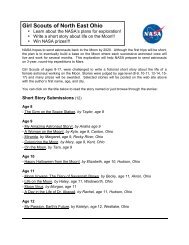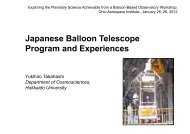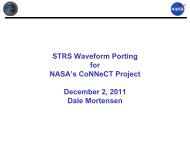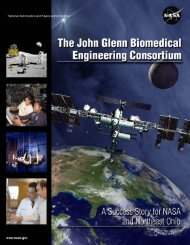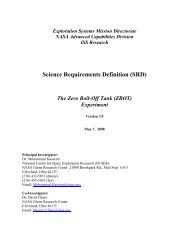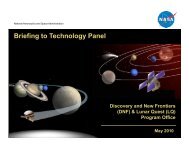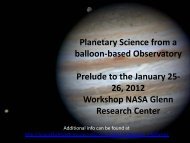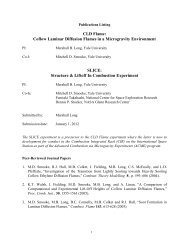Amusement Park Physics With a NASA Twist - Space Flight Systems ...
Amusement Park Physics With a NASA Twist - Space Flight Systems ...
Amusement Park Physics With a NASA Twist - Space Flight Systems ...
You also want an ePaper? Increase the reach of your titles
YUMPU automatically turns print PDFs into web optimized ePapers that Google loves.
Errors in Measurement<br />
Whenever something such as the thickness of a book or the length of a table is measured, there is<br />
always error involved in the measurement process. It doesn’t mean that the person performing the<br />
measuring has measured it wrong. It is inherent in the measuring process. No measuring device is or<br />
can be 100 percent precise. For example, if one is using a ruler to measure length, and the smallest<br />
division on the ruler is 1/8 of an inch, the precision of that ruler is 1/8 of an inch. If the smallest division is<br />
1/16 of an inch, then the precision is 1/16 of an inch. Notice that by dividing the ruler into more divisions,<br />
the greater the precision, but it can never measure anything perfectly. This is not possible for any<br />
measurement tool. For this to be so, the tool would have to have an infinite number of divisions. Because<br />
we are always limited to finite-scale measuring instruments, there will always be an associated<br />
uncertainty called error. Also, remember that if your ruler only measures with a precision of 1/8 of an<br />
inch, you cannot state that you found a length to the nearest 1/16. Your measurement device will not<br />
allow you to have that high of a precision.<br />
Since some tools have more divisions than others, some are more precise than others. Using more<br />
precise tools means that one’s answer is a better estimate of the actual length, but it is still an estimate.<br />
At the amusement park, the tools used to perform these activities are not very precise. They only give a<br />
rough estimate of the actual measurements allowing the student to make observations and predictions<br />
based on patterns. The answer key and the measures and values that are found are also not exact. The<br />
teacher should expect to have answers that are in the range of those found in the key.<br />
In some instances the student will be pacing to find some distances, using estimation of structures, and<br />
using eye level for height. Because they will not be using a standardized measurement device, such as<br />
a ruler, expect a large amount of error. Every time the student records a measurement, consider the<br />
possible sources of error. By increasing the number of times that he or she takes a measurement, the<br />
average or mean value of these measurements will more closely resemble the actual value of the<br />
quantity he or she is trying to measure assuming that the student used the tool correctly. This is because<br />
he or she is just as likely to measure a value that is slightly too high as one that is too low, therefore,<br />
these errors will “average themselves out.”<br />
If a value that is recorded involves an estimate that is to be multiplied with another estimated value, the<br />
error is multiplied also. This is called error propagation, and it can be significant, especially when there<br />
are several steps of measurements multiplied within a problem. It cannot be avoided, but be aware that<br />
along with the measurements, the error continues to be multiplied and it is inherent in the final value.<br />
As an example, if the students want to measure the base of a roller coaster hill, they would pace off the<br />
distance, using their pacing distance. If they estimate that two of their steps is about a meter in length,<br />
there is some error in this measurement. Also, they may not take the same size steps each time. So<br />
when they walk a 30-meter baseline, this error increases. However, the longer the distance, the more<br />
likely the short and long steps will average themselves out, thus giving them a better overall estimate.<br />
The use of the altitude tracker to measure the height of a structure can allow for more errors. Did they<br />
look through the same part of the hole; did they sight to the top of the structure at the same point each<br />
time—in other words, were they consistent when taking their measurements This gives the student<br />
some idea of why there is no “exact” answer when taking measurements. Scientists and researchers<br />
always try to reduce the error as much as possible, but some error is always present.<br />
41<br />
<strong>Amusement</strong> <strong>Park</strong> <strong>Physics</strong> <strong>With</strong> a <strong>NASA</strong> <strong>Twist</strong><br />
EG–2003–03–010–GRC



